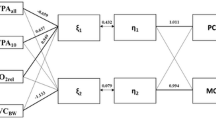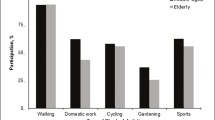Abstract
Purpose
The purpose of this study was to investigate the contribution of sport to the association between physical activity (PA) and quality of life (QoL).
Methods
Cross-sectional data were gathered on 4,909 subjects (age 15–69) from the French National Barometer 2005 survey. The International Physical Activity Questionnaire (IPAQ) and the abbreviated version of the World Health Organization Quality of Life Questionnaire (WHOQOL-BREF) were administered. An additional question was used to assess sporting activity. All analyses used linear regression models and were adjusted on variables associated with QoL in a general population.
Results
The mean age of the participants (both men and women) decreased with increasing PA level. Sport was positively associated with QoL among men (β range from 4.2 [95 % CI 3.1–5.4] for physical health to 2.4 [95 % CI 1.1–3.8] for social relationship domains) and women (β range from 3.6 [95 % CI 2.6–4.5] for physical health to 1.6 [95 % CI 0.6–2.8] for social relationship domains). The association between sport and QoL was greater for low or high PA levels rather than moderate PA for men (physical and psychological health) and women (physical health only). For women, there was a dose–response association with psychological health and social relationships (contribution of sport to QoL increased with PA level).
Conclusions
These results showed that sport was nearly always associated with better QoL, even more so for people who had low or high PA levels (physical and psychological health for men and physical health for women). Prospective studies are necessary to confirm these findings.

Similar content being viewed by others
References
Physical Activity Guidelines Advisory Committee. (2008). Physical activity guidelines advisory committee report, 2008. Washington, DC: US Department of Health and Human Services. www.health.gov/paguidelines/reports/pdf/committeeReport.pdf. Accessed February 15, 2012.
Lee, I. M., Shiroma, E. J., Lobelo, F., Puska, P., Blair, S. N., & Katzmarzyk, P. T. (2012). Effect of physical inactivity on major non-communicable diseases worldwide: An analysis of burden of disease and life expectancy. Lancet, 380(9838), 219–229.
Warburton, D. E., Nicol, C. W., & Bredin, S. S. (2006). Health benefits of physical activity: The evidence. CMAJ, 174(6), 801–809.
Skevington, S. M., Sartorius, N., & Amir, M. (2004). Developing methods for assessing quality of life in different cultural settings. The history of the WHOQOL instruments. Social Psychiatry and Psychiatric Epidemiology, 39(1), 1–8.
Esteban, C., Quintana, J. M., Aburto, M., Moraza, J., Egurrola, M., Perez-Izquierdo, J., et al. (2010). Impact of changes in physical activity on health-related quality of life among patients with COPD. The European Respiratory Journal, 36(2), 292–300.
Gardner, A. W., Montgomery, P. S., Ritti-Dias, R. M., & Thadani, U. (2011). Exercise performance, physical activity, and health-related quality of life in participants with stable angina. Angiology, 62(6), 461–466.
Speyer, E., Herbinet, A., Vuillemin, A., Briançon, S., & Chastagner, P. (2010). Effect of adapted physical activity sessions in the hospital on health-related quality of life for children with cancer: A cross-over randomized trial. Pediatric Blood & Cancer, 55(6), 1160–1166.
Stroud, N. M., & Minahan, C. L. (2009). The impact of regular physical activity on fatigue, depression and quality of life in persons with multiple sclerosis. Health and Quality of Life Outcomes, 7, 68.
Thorsen, L., Skovlund, E., Stromme, S. B., Hornslien, K., Dahl, A. A., & Fossa, S. D. (2005). Effectiveness of physical activity on cardiorespiratory fitness and health-related quality of life in young and middle-aged cancer patients shortly after chemotherapy. Journal of Clinical Oncology, 23(10), 2378–2388.
Thorsen, L., Courneya, K. S., Stevinson, C., & Fossa, S. D. (2008). A systematic review of physical activity in prostate cancer survivors: Outcomes, prevalence, and determinants. Supportive Care in Cancer, 16(9), 987–997.
Bize, R., Johnson, J. A., & Plotnikoff, R. C. (2007). Physical activity level and health-related quality of life in the general adult population: A systematic review. Preventive Medicine, 45(6), 401–415.
Brown, D. W., Brown, D. R., Heath, G. W., Balluz, L., Giles, W. H., Ford, E. S., et al. (2004). Associations between physical activity dose and health-related quality of life. Medicine and Science in Sports and Exercise, 36(5), 890–896.
Wolin, K. Y., Glynn, R. J., Colditz, G. A., Lee, I. M., & Kawachi, I. (2007). Long-term physical activity patterns and health-related quality of life in US women. American Journal of Preventive Medicine, 32(6), 490–499.
Balboa-Castillo, T., Leon-Munoz, L. M., Graciani, A., Rodriguez-Artalejo, F., & Guallar-Castillon, P. (2011). Longitudinal association of physical activity and sedentary behaviour during leisure time with health-related quality of life in community-dwelling older adults. Health and Quality of Life Outcomes, 9, 47.
Jurakic, D., Pedisic, Z., & Greblo, Z. (2010). Physical activity in different domains and health-related quality of life: A population-based study. Quality of Life Research, 19(9), 1303–1309.
Tessier, S., Vuillemin, A., Bertrais, S., Boini, S., Le, B. E., Oppert, J. M., et al. (2007). Association between leisure-time physical activity and health-related quality of life changes over time. Preventive Medicine, 44(3), 202–208.
Valadares, A. L., Carvalho, E. D., Costa-Paiva, L. H., Morais, S. S., & Pinto-Neto, A. M. (2011). Association between different types of physical activities and quality of life in women aged 60 years or over. Revista da Associação Médica Brasileira, 57(4), 450–455.
Vuillemin, A., Boini, S., Bertrais, S., Tessier, S., Oppert, J. M., Hercberg, S., et al. (2005). Leisure time physical activity and health-related quality of life. Preventive Medicine, 41(2), 562–569.
Hakkinen, A., Rinne, M., Vasankari, T., Santtila, M., Hakkinen, K., & Kyrolainen, H. (2010). Association of physical fitness with health-related quality of life in Finnish young men. Health and Quality of Life Outcomes, 8, 15.
Samitz, G., Egger, M., & Zwahlen, M. (2011). Domains of physical activity and all-cause mortality: Systematic review and dose-response meta-analysis of cohort studies. International Journal Epidemiology, 40(5), 1382–1400.
Donaldson, A., & Finch, C. F. (2012). Sport as a setting for promoting health. British Journal of Sports Medicine, 46(1), 4–5.
Wilhite, B., & Shank, J. (2009). In praise of sport: promoting sport participation as a mechanism of health among persons with a disability. Disability and Health Journal, 2(3), 116–127.
Suominen, H. (2006). Muscle training for bone strength. Aging Clinical and Experimental Research, 18(2), 85–93.
Suominen, H. (1993). Bone mineral density and long term exercise An overview of cross-sectional athlete studies. Sports Medicine, 16(5), 316–330.
Snyder, A. R., Martinez, J. C., Bay, R. C., Parsons, J. T., Sauers, E. L., & Valovich McLeod, T. C. (2010). Health-related quality of life differs between adolescent athletes and adolescent nonathletes. Journal of Sport Rehabilitation, 19(3), 237–248.
INPES. Barometre Santé 2005. (2005). www.inpes.sante.fr/CFESBases/catalogue/pdf/1109.pdf. Accessed October 17, 2011.
Leplege, A., Reveillere, C., Ecosse, E., Caria, A., & Riviere, H. (2000). Psychometric properties of a new instrument for evaluating quality of life, the WHOQOL-26, in a population of patients with neuromuscular diseases. Encephale, 26(5), 13–22.
Rutten, A., Ziemainz, H., Schena, F., Stahl, T., Stiggelbout, M., Auweele, Y. V., et al. (2003). Using different physical activity measurements in eight European countries. Results of the European Physical Activity Surveillance System (EUPASS) time series survey. Public Health Nutrition, 6(4), 371–376.
IPAQ Research Committee. (2005). Guidelines for data processing and analysis of the international physical activity questionnaire (IPAQ)—short and long forms. http://www.ipaq.ki.se/scoring.pdf. Accessed September 20, 2011.
Cole, T. J., Bellizzi, M. C., Flegal, K. M., & Dietz, W. H. (2000). Establishing a standard definition for child overweight and obesity worldwide: International survey. BMJ, 320(7244), 1240–1243.
Baumann, C., Erpelding, M. L., Regat, S., Collin, J. F., & Briançon, S. (2010). The WHOQOL-BREF questionnaire: French adult population norms for the physical health, psychological health and social relationship dimensions. Revue d’épidémiologie et de santé publique, 58(1), 33–39.
Jaracz, K., Kalfoss, M., Gorna, K., & Baczyk, G. (2006). Quality of life in polish respondents: Psychometric properties of the Polish WHOQOL-Bref. Scandinavian Journal of Caring Sciences, 20(3), 251–260.
Noerholm, V., Groenvold, M., Watt, T., Bjorner, J. B., Rasmussen, N. A., & Bech, P. (2004). Quality of life in the Danish general population–normative data and validity of WHOQOL-BREF using Rasch and item response theory models. Quality of Life Research, 13(2), 531–540.
Eime, R. M., Harvey, J. T., Brown, W. J., & Payne, W. R. (2010). Does sports club participation contribute to health-related quality of life? Medicine and Science in Sports and Exercise, 42(5), 1022–1028.
Riise, T., Moen, B. E., & Nortvedt, M. W. (2003). Occupation, lifestyle factors and health-related quality of life: The Hordaland health study. Journal of Occupational and Environmental Medicine, 45(3), 324–332.
Shibata, A., Oka, K., Nakamura, Y., & Muraoka, I. (2007). Recommended level of physical activity and health-related quality of life among Japanese adults. Health and Quality of Life Outcomes, 5, 64.
Kim, I., Choi, H., & Davis, A. H. (2010). Health-related quality of life by the type of physical activity in Korea. Journal of Community Health Nursing, 27(2), 96–106.
Tan, S.Y., Poh, B.K., Chong, H.X., Ismail, M.N., Rahman, J., Zarina, A.L., et al. (2013). Physical activity of pediatric patients with acute leukemia undergoing induction or consolidation chemotherapy. Leukemia Research, 37, 14–20.
Lynch, B. M., Cerin, E., Newman, B., & Owen, N. (2007). Physical activity, activity change, and their correlates in a population-based sample of colorectal cancer survivors. Annals of Behavioral Medicine, 34(2), 135–143.
Programme National Nutrition Santé. (2001). http://www.sante.gouv.fr/IMG/pdf/PNNS_2011-2015.pdf. Accessed November 25, 2012.
Acknowledgments
Data collection for this study was financially supported by the National Institute for Prevention and Health Education (INPES), Paris, France.
Conflict of interest
All authors declare that they have no competing interest.
Author information
Authors and Affiliations
Corresponding author
Rights and permissions
About this article
Cite this article
Omorou, Y.A., Erpelding, ML., Escalon, H. et al. Contribution of taking part in sport to the association between physical activity and quality of life. Qual Life Res 22, 2021–2029 (2013). https://doi.org/10.1007/s11136-013-0355-3
Accepted:
Published:
Issue Date:
DOI: https://doi.org/10.1007/s11136-013-0355-3




